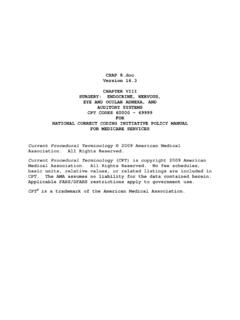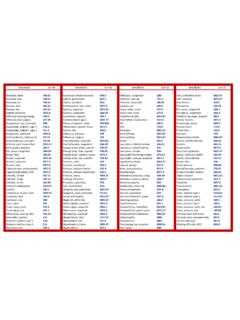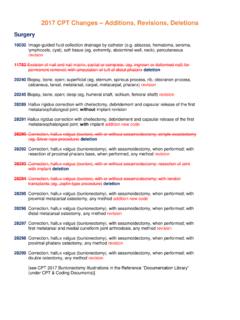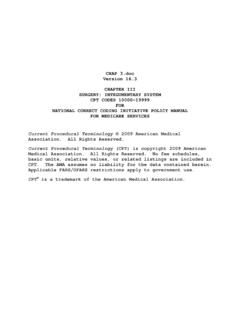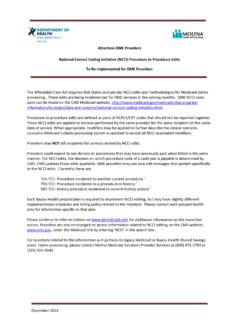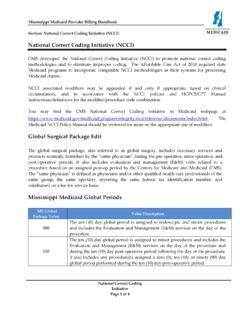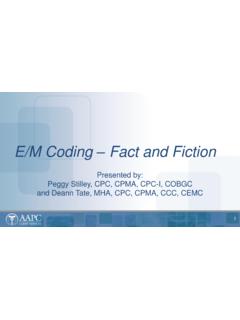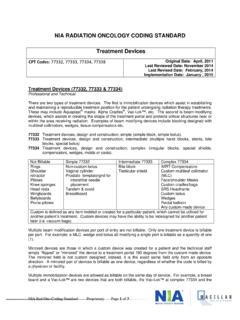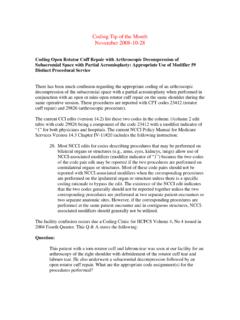Transcription of CHAP 1.doc Version 16.3 CHAPTER I GENERAL …
1 CHAP Version CHAPTER I GENERAL correct coding POLICIES FOR national correct coding initiative POLICY MANUAL FOR MEDICARE SERVICES Current Procedural Terminology 2009 American Medical Association. All Rights Reserved. Current Procedural Terminology (CPT) is copyright 2009 American Medical Association. All Rights Reserved. No fee schedules, basic units, relative values, or related listings are included in CPT. The AMA assumes no liability for the data contained herein. Applicable FARS/DFARS restrictions apply to government use. CPT is a trademark of the American Medical Association.
2 Version I-1 CHAPTER I GENERAL correct coding Policies A. Introduction Healthcare providers utilize HCPCS/CPT codes to report medical services performed on patients to Medicare Carriers (A/B MACs processing practitioner service claims) and Fiscal Intermediaries (FIs). HCPCS (Healthcare Common Procedure coding System) consists of Level I CPT (Current Procedural Terminology) codes and Level II codes. CPT codes are defined in the American Medical Association s (AMA) CPT Manual which is updated and published annually. HCPCS Level II codes are defined by the Centers for Medicare and Medicaid Services (CMS) and are updated throughout the year as necessary.
3 Changes in CPT codes are approved by the AMA CPT Editorial Panel which meets three times per year. CPT and HCPCS Level II codes define medical and surgical procedures performed on patients. Some procedure codes are very specific defining a single service ( , CPT code 93000 (electrocardiogram)) while other codes define procedures consisting of many services ( , CPT code 58263 (vaginal hysterectomy with removal of tube(s) and ovary(s) and repair of enterocele)). Because many procedures can be performed by different approaches, different methods, or in combination with other procedures, there are often multiple HCPCS/CPT codes defining similar or related procedures.
4 CPT and HCPCS Level II code descriptors usually do not define all services included in a procedure. There are often services inherent in a procedure or group of procedures. For example, anesthesia services include certain preparation and monitoring services. The CMS developed the NCCI to prevent inappropriate payment of services that should not be reported together. There are two NCCI edit tables: Column One/Column Two correct coding Edit Table and Mutually Exclusive Edit Table . Each edit table contains edits which are pairs of HCPCS/CPT codes that in GENERAL should not be reported together.
5 Each edit has a column one and column two HCPCS/CPT code. If a provider reports the two codes of an edit pair, the column two code is denied, and the column one code is eligible for payment. However, if it is clinically appropriate to utilize an NCCI-associated modifier, both the Version I-2 column one and column two codes are eligible for payment. (NCCI-associated modifiers and their appropriate use are discussed elsewhere in this CHAPTER .) All edits are included in the Column One/Column Two correct coding Edit Table except those that are based on the mutually exclusive ( CHAPTER I, Section P) and gender-specific ( CHAPTER I, Section Q) criteria in which case the edits are included in the Mutually Exclusive Edit Table.
6 When the NCCI was first established and during its early years, the Column One/Column Two correct coding Edit Table was termed the Comprehensive/Component Edit Table . This latter terminology was a misnomer. Although the column two code is often a component of a more comprehensive column one code, this relationship is not true for many edits. In the latter type of edit the code pair edit simply represents two codes that should not be reported together. For example, a provider should not report a vaginal hysterectomy code and total abdominal hysterectomy code together.
7 In this Manual many policies are described utilizing the term physician . Unless indicated differently the usage of this term does not restrict the policies to physicians only but applies to all practitioners, hospitals, providers, or suppliers eligible to bill the relevant HCPCS/CPT codes pursuant to applicable portions of the Social Security Act (SSA) of 1965, the Code of Federal Regulations (CFR), and Medicare rules. In some sections of this Manual, the term physician would not include some of these entities because specific rules do not apply to them. For example, Anesthesia Rules and Global Surgery Rules do not apply to hospitals.
8 In 2010 the CPT Manual modified the numbering of codes so that the sequence of codes as they appear in the CPT Manual does not necessarily correspond to a sequential numbering of codes. In the national correct coding initiative Policy Manual for Medicare Services, use of a numerical range of codes reflects all codes that numerically fall within the range regardless of their sequential order in the CPT Manual. This CHAPTER addresses GENERAL coding principles, issues, and policies. Many of these principles, issues, and policies are addressed further in subsequent chapters dealing with specific groups of HCPCS/CPT codes.
9 In this CHAPTER examples are often utilized to clarify principles, issues, or policies. The Version I-3 examples do not represent the only codes to which the principles, issues, or policies apply. B. coding Based on Standards of Medical/Surgical Practice Most HCPCS/CPT code defined procedures include services that are integral to them. Some of these integral services have specific CPT codes for reporting the service when not performed as an integral part of another procedure. (For example, CPT code 36000 (introduction of needle or intracatheter into a vein) is integral to all nuclear medicine procedures requiring injection of a radiopharmaceutical into a vein.)
10 CPT code 36000 is not separately reportable with these types of nuclear medicine procedures. However, CPT code 36000 may be reported alone if the only service provided is the introduction of a needle into a vein.) Other integral services do not have specific CPT codes. (For example, wound irrigation is integral to the treatment of all wounds and does not have a HCPCS/CPT code.) Services integral to HCPCS/CPT code defined procedures are included in those procedures based on the standards of medical/surgical practice. It is inappropriate to separately report services that are integral to another procedure with that procedure.
